This article needs additional citations for verification .(May 2023) |
Vermes ("worms") is an obsolete taxon used by Carl Linnaeus and Jean-Baptiste Lamarck for non-arthropod invertebrate animals.
This article needs additional citations for verification .(May 2023) |
Vermes ("worms") is an obsolete taxon used by Carl Linnaeus and Jean-Baptiste Lamarck for non-arthropod invertebrate animals.
In Linnaeus's Systema Naturae , the Vermes had the rank of class, occupying the 6th (and last) slot of his animal systematics. It was divided into the following orders, all except the Lithophyta containing (in modern terms) organisms from a variety of phyla: [1]
Apart from the Mollusca, understood very differently from the modern phylum of that name, Linnaeus included a very diverse and rather mismatched assemblage of animals in the categories. The Intestina group encompassed various parasitic animals, among them the hagfish, which Linnaeus would have found in dead fish. Shelled molluscs were placed in the Testacea, together with barnacles and tube worms. Cnidarians (jellyfish and corals), Echinoderms and polychaetes were spread across the other orders.
Linnaeus's system was revised by Jean-Baptiste Lamarck in his 1801 Système des Animaux sans Vertebres. In this work, he categorized echinoderms, arachnids, crustaceans and annelids, which he separated from Vermes. [2]
After Linnaeus, and especially with the advent of Darwinism, it became apparent that the Vermes animals are not closely related. Systematic works on phyla since Linnaeus continued to split up Vermes and sort the animals into natural systematic units.
Of the classes of Vermes proposed by Linnaeus, only Mollusca has been kept as a phylum, and its composition has changed almost entirely. Linnaeus's early classification of the soft-bodied organisms was revolutionary in its day. A number of the organisms classified as Vermes by Linnaeus were very poorly known, and a number of them were not even viewed as animals.

While the Vermes is no longer a taxonomic group, anatomists continue to use the description "vermiform" of animals or organs that are worm-shaped. The word root is Latin, vermes(worms) and formes(shaped). [3] A well known example is the vermiform appendix, a small, blind section of the gut in humans and a number of other mammals. [4]
Several soft-bodied animal phyla including the annelids (earthworm and relatives) and the roundworms (mainly parasites), but also the minute parasitic mesozoans and some larger-bodied free-living phyla like the ribbon worms, peanut worms, and priapulids.
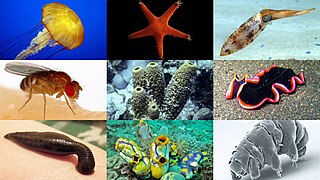
Invertebrates is an umbrella term describing animals that neither develop nor retain a vertebral column, which evolved from the notochord. It is a paraphyletic grouping including all animals excluding the chordate subphylum Vertebrata, i.e. vertebrates. Well-known phyla of invertebrates include arthropods, mollusks, annelids, echinoderms, flatworms, cnidarians, and sponges.

Linnaean taxonomy can mean either of two related concepts:

The Sipuncula or Sipunculida is a class containing about 162 species of unsegmented marine annelid worms. Sipuncula was once considered a phylum, but was demoted to a class of Annelida, based on recent molecular work.

Polychaeta is a paraphyletic class of generally marine annelid worms, commonly called bristle worms or polychaetes. Each body segment has a pair of fleshy protrusions called parapodia that bear many bristles, called chaetae, which are made of chitin. More than 10,000 species are described in this class. Common representatives include the lugworm and the sandworm or clam worm Alitta.
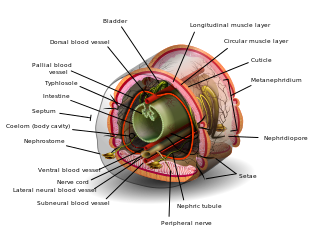
The coelom is the main body cavity in many animals and is positioned inside the body to surround and contain the digestive tract and other organs. In some animals, it is lined with mesothelium. In other animals, such as molluscs, it remains undifferentiated. In the past, and for practical purposes, coelom characteristics have been used to classify bilaterian animal phyla into informal groups.

Systema Naturae is one of the major works of the Swedish botanist, zoologist and physician Carl Linnaeus (1707–1778) and introduced the Linnaean taxonomy. Although the system, now known as binomial nomenclature, was partially developed by the Bauhin brothers, Gaspard and Johann, Linnaeus was the first to use it consistently throughout his book. The first edition was published in 1735. The full title of the 10th edition (1758), which was the most important one, was Systema naturæ per regna tria naturæ, secundum classes, ordines, genera, species, cum characteribus, differentiis, synonymis, locis, which appeared in English in 1806 with the title: "A General System of Nature, Through the Three Grand Kingdoms of Animals, Vegetables, and Minerals, Systematically Divided Into their Several Classes, Orders, Genera, Species, and Varieties, with their Habitations, Manners, Economy, Structure and Peculiarities".
Invertebrate zoology is the subdiscipline of zoology that consists of the study of invertebrates, animals without a backbone.

Soft-bodied organisms are organisms that lack rigid physical skeletons or frame, roughly corresponds to the group Vermes as proposed by Carl von Linné. The term typically refers to those from the kingdom Animalia, although many non-vascular plants, fungi, lichens and slime molds are also soft-bodied organisms by definition.
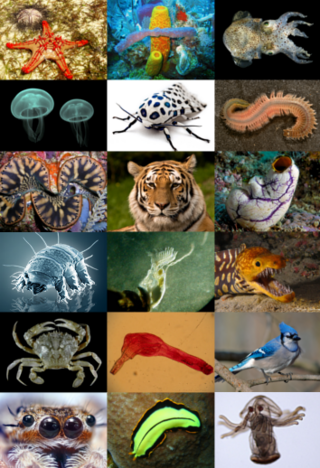
A body plan, Bauplan, or ground plan is a set of morphological features common to many members of a phylum of animals. The vertebrates share one body plan, while invertebrates have many.
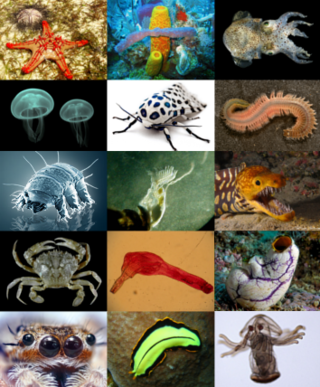
Animals are multicellular, eukaryotic organisms in the biological kingdom Animalia. With few exceptions, animals consume organic material, breathe oxygen, have myocytes and are able to move, can reproduce sexually, and grow from a hollow sphere of cells, the blastula, during embryonic development. Animals form a clade, meaning that they arose from a single common ancestor.

The taxonomy of commonly fossilized invertebrates combines both traditional and modern paleozoological terminology. This article compiles various invertebrate taxa in the fossil record, ranging from protists to arthropods. This includes groups that are significant in paleontological contexts, abundant in the fossil record, or have a high proportion of extinct species. Special notations are explained below:

Marine invertebrates are the invertebrates that live in marine habitats. Invertebrate is a blanket term that includes all animals apart from the vertebrate members of the chordate phylum. Invertebrates lack a vertebral column, and some have evolved a shell or a hard exoskeleton. As on land and in the air, marine invertebrates have a large variety of body plans, and have been categorised into over 30 phyla. They make up most of the macroscopic life in the oceans.

Worms are many different distantly related bilateral animals that typically have a long cylindrical tube-like body, no limbs, and usually no eyes.

Tritia reticulata, common name the "netted dog whelk", is a species of small European sea snail, a marine gastropod mollusc in the family Nassariidae, the dog whelks or nassa mud snails.

Stramonita haemastoma, common name the red-mouthed rock shell or the Florida dog winkle, is a species of predatory sea snail, a marine gastropod mollusc in the family Muricidae, the rock snails.
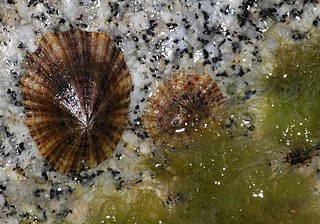
Patella caerulea, is a species of limpet in the family Patellidae. It is known by the common names Mediterranean limpet and rayed Mediterranean limpet. It is native to the Mediterranean Sea.

The 10th edition of Systema Naturae is a book written by Swedish naturalist Carl Linnaeus and published in two volumes in 1758 and 1759, which marks the starting point of zoological nomenclature. In it, Linnaeus introduced binomial nomenclature for animals, something he had already done for plants in his 1753 publication of Species Plantarum.

The annelids, also known as the segmented worms, are a large phylum, with over 22,000 extant species including ragworms, earthworms, and leeches. The species exist in and have adapted to various ecologies – some in marine environments as distinct as tidal zones and hydrothermal vents, others in fresh water, and yet others in moist terrestrial environments.

Le Règne Animal is the most famous work of the French naturalist Georges Cuvier. It sets out to describe the natural structure of the whole of the animal kingdom based on comparative anatomy, and its natural history. Cuvier divided the animals into four embranchements, namely vertebrates, molluscs, articulated animals, and zoophytes.
{{cite journal}}: CS1 maint: multiple names: authors list (link)